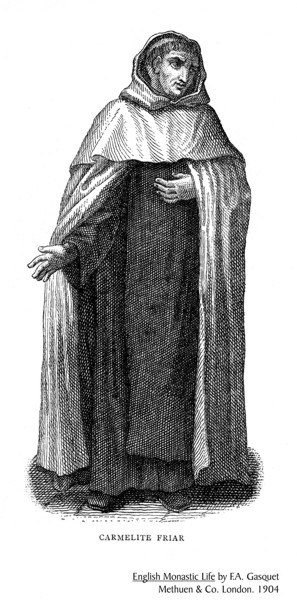|
Carmelite Friars
Carmelite Friars and nuns
are active in today's world as they were in the Middle Ages. On
this page you
will
find links to current and historical information about the order, as
well as information from
Abbot
Gasquet's book English
Monastic
Life. Gasquet published the book through The Antiquaries
Book
series in
1904. It is now out of print and not generally available.
There may
be a number of factual errors in the text, or points on which
historians or theologians do not agree. Gasquet's
text, notes & links>>
|
 |
|
The Friars
The friars
differed from the monks
in certain ways. The brethren by their
profession were bound, not to any locality or house, but to the
province, which
usually consisted of the entire number of houses in a country. They did not, consequently, form individual
families in their various establishments, like the monks in their
monasteries. They also, at first,
professed the strictest poverty, not being allowed to possess even
corporate
property like the monastic Orders. They
were by their profession mendicants, living on alms, and only holding
the mere
buildings in whey they dwelt.
Carmelites
The Carmelite
Friars were so called from the place of their
origin. They were also named “White
Friars” from the colour of the cloak of their habit, and Friars of the
Blessed
Virgin. These friars are first heard of
in the twelfth century, on being driven out of Palestine
by the persecution of the Saracens. Their
Rule is chiefly founded on that of St. Basil,
and was confirmed by
Pope Honorius III, in A.D. 1224, and finally approved by Innocent VI,
in
1250. They were brought into England
by John Vesey and Richard Grey, and established their first houses in
the north
at Alnwick, and in the south at Ailesford in Kent. At the latter place the first European
Chapter of the Order was held in A.D. 1245. In
the sixteenth century there were about forty
houses in England
and Wales.
English
Monastic Life by
F.A. Gasquet. (pages 234 & 241.)
|
Carmelite Houses in England (Gasquet doesn't give a lot of
information about Carmelite houses in his index. All that is
available is listed here. For more English
Religious Houses, see the index page):
|
Allerton, North
|
Yorks, W. R.
|
|
Alnwick (see Holne)
|
Northumberland.
|
|
Appleby
|
Westmoreland.
|
|
Aylesford
|
Kent.
|
|
Blakeney, or Sniterley
|
Norfolk.
|
|
Boston
|
Lincoln.
|
|
Bristol
|
Somerset.
|
|
Burham Norton
|
Norfolk.
|
|
Cambridge
|
Cambridge.
|
|
Cardiff
|
Glamorgan.
|
|
Chester
|
Cheshire.
|
|
Coventry
|
Warwick.
|
|
Denbigh
|
Denbigh.
|
|
Doncaster
|
Yorks, W. R.
|
|
Gloucester
|
Gloucester.
|
|
Hitchin
|
Herts.
|
|
Hull
|
Yorks, E. R.
|
|
Hulne (Alnwick)
|
Northumberland.
|
|
Ipswich
|
Suffolk.
|
|
Lenton
|
Notts.
|
|
Lincoln
|
Lincoln.
|
|
London
|
Middlesex.
|
|
Losenham, in Newenden
|
Kent.
|
|
Ludlow
|
Salop.
|
|
Lynn
|
Norfolk.
|
|
Maldon
|
Essex.
|
|
Marlborough
|
Wilts.
|
|
Newcastle-on-Tyne
|
Northumberland.
|
|
Northhampton
|
Northants.
|
|
Norwich
|
Norfolk.
|
|
Nottingham
|
Notts.
|
|
Oxford
|
Oxford.
|
|
Plymouth
|
Devon.
|
|
Pontefract
|
Yorks, W. R.
|
|
Ruthin
|
Denbigh.
|
|
Sandwich
|
Kent.
|
|
Shoreham, New
|
Sussex.
|
|
Stamford
|
Northants.
|
|
Taunton
|
Somerset.
|
|
Winchester
|
Hants.
|
|
Yarmouth
|
Norfolk.
|
|
York
|
Yorks.
|
|
Carmelite Links:
A wonderful site, beautifully laid out: The Virtual Carmelite Museum.
The British Province of Carmelites, a lovely page with links to
pictures and information to three medieval friaries: Hulne, Coventry, and Hitchin.
Through the Carmelites.info
page, links to monasteries of the Carmelite Nuns, and
listings of the Carmelite
Hermit Communities.
The 'Discalced
(Teresian) Carmelite Family in England, Scotland and Wales.
The
Carmelite Order, an article from Newadvent.org.
'Friaries:
Carmelite Friars', especially the Carmelite Friars of Ludlow.
A History of the County
of Shropshire: Volume 2 (1973), pp. 93-5. URL:
http://www.british-history.ac.uk/report.asp?compid=39936. From
British History Online.
Corrections,
questions?  |
|
Historyfish
pages, content, and design copyright (c) Richenda
Fairhurst, 2008
All rights reserved. No commercial permissions are
granted.
The Historyfish site, as a
particular and so
unique "expression," is copyright. However, some (most) source
material is part of the public domain, and so free of copyright
restrictions. Where those sections are not clearly marked, please
contact me so I can assist in identifying and separating that material
from the Historyfish site as a whole.
When using material from this site,
please keep
author, source, and
copyright permissions with this article.
Historyfish intends to generate discussion
through shared
information and does not claim to provide,
in any way, formal, legal, or factual advice or information. These
pages are opinion only. Opinions shared on historyfish are
not necessarily
the
opinions of historyfish editors, staff, owners or
administrators. Always consult
proper authorities with questions pertaining to copyrights, property
rights, and intellectual property rights.
It is my intent to follow copyright law (however
impossibly convoluted
that may be). Please contact me should any material included here be
copyright protected and posted in error. I will remove it from the
site. Thank you. |
|
